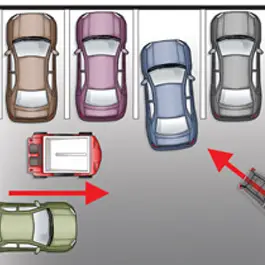How does a car’s parking system with rear traffic alert work?


Car parking systems with rear traffic alert are an essential feature in modern vehicles that enhance car safety and driver assistance. These systems utilize advanced vehicle technology, including parking sensors and automotive electronics, to provide collision avoidance and assist drivers in maneuvering their vehicles in tight parking spaces. In this article, we will explore how a car’s parking system with rear traffic alert works, discussing its components, functionality, and benefits.
Components of a Car Parking System with Rear Traffic Alert
A car parking system with rear traffic alert typically consists of the following components:
1. Parking Sensors: These sensors are strategically placed on the front and rear bumpers of the vehicle. They use ultrasonic or electromagnetic technology to detect obstacles or other vehicles in close proximity.
2. Rearview Camera: Many modern vehicles are equipped with a rearview camera that provides a live video feed of the area behind the vehicle. This camera helps the driver to have a clear view while parking and maneuvering.
3. Control Unit: The control unit acts as the brain of the parking system. It receives information from the parking sensors and rearview camera and processes it to provide alerts and assistance to the driver.
4. Display Unit: The display unit, usually located on the dashboard or infotainment system, shows visual and audible alerts to the driver. It may also display a live feed from the rearview camera.
Functionality of a Car Parking System with Rear Traffic Alert
When a driver engages the car parking system with rear traffic alert, the system continuously monitors the vehicle’s surroundings using the parking sensors and rearview camera. Here’s how the system works:
1. Detection of Obstacles: The parking sensors detect obstacles or other vehicles in the vicinity of the vehicle. They emit ultrasonic or electromagnetic waves and measure the time it takes for the waves to bounce back. Based on this information, the system determines the distance between the vehicle and the obstacle.
2. Alerting the Driver: If the parking sensors detect an obstacle, the control unit processes the information and alerts the driver through visual and audible signals. The display unit may show a visual representation of the vehicle and the detected obstacle, along with the distance between them. The driver may also hear beeping sounds that increase in frequency as the vehicle gets closer to the obstacle.
3. Rear Traffic Alert: In addition to detecting obstacles, the parking system with rear traffic alert can also detect approaching vehicles from the sides. This feature is particularly useful when reversing out of a parking space or driveway. The system uses the rearview camera and parking sensors to monitor the sides of the vehicle and alerts the driver if it detects a vehicle approaching from either side.
4. Automatic Braking: Some advanced car parking systems with rear traffic alert are equipped with automatic braking capabilities. If the system detects an imminent collision with an obstacle or another vehicle, it can automatically apply the brakes to prevent or minimize the impact.
Benefits of a Car Parking System with Rear Traffic Alert
Car parking systems with rear traffic alert offer several benefits to drivers, including:
1. Enhanced Safety: By providing real-time alerts and assistance, these systems significantly enhance car safety. They help drivers avoid collisions with obstacles, pedestrians, and other vehicles, reducing the risk of accidents and injuries.
2. Improved Maneuverability: Parking in tight spaces can be challenging, especially for inexperienced drivers. The parking system with rear traffic alert makes maneuvering easier by providing accurate distance measurements and visual guidance.
3. Time and Effort Savings: With the assistance of the parking system, drivers can park their vehicles more quickly and efficiently. This saves time and effort, especially in crowded parking lots or urban areas where finding a parking space can be a daunting task.
4. Damage Prevention: The parking sensors and rearview camera help drivers avoid accidental collisions with walls, curbs, or other stationary objects. This prevents damage to the vehicle and reduces repair costs.
In conclusion, a car parking system with rear traffic alert is a valuable feature that enhances car safety, driver assistance, and overall convenience. By utilizing parking sensors, rearview cameras, and advanced automotive electronics, these systems provide real-time alerts, assist drivers in maneuvering their vehicles, and help prevent collisions. Investing in a vehicle equipped with this technology can significantly improve the parking experience and reduce the risk of accidents and damage.
Recent Posts
How do I create an engaging and informative online quiz or assessment?
Creating an engaging and informative online quiz or assessment can be a powerful tool for… Read More
What are the most effective methods for managing and reducing work-related stress in the hospitality industry?
Work-related stress is a common issue in the hospitality industry, where employees often face long… Read More
How can I improve my assertiveness and communication skills in a leadership position?
In a leadership position, assertiveness and effective communication skills are crucial for success. Being able… Read More
What are the key elements of a successful employee recognition and rewards program?
Employee recognition and rewards programs play a crucial role in motivating and engaging employees, as… Read More
How do I effectively manage and respond to customer feedback and reviews?
Customer feedback and online reviews play a crucial role in shaping a company's reputation and… Read More
What are the best strategies for effective time management as a stay-at-home parent?
Effective time management is crucial for stay-at-home parents who juggle multiple responsibilities on a daily… Read More